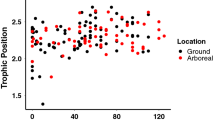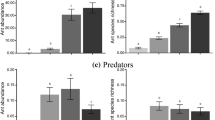Summary
The relation between ant-plant specificity and the use of host plants as a resource was investigated in the facultative, myrmecophytic orchid, Caularthron bilamellatum (Rchg.f.) Schult. Using stable isotopes, we determined the portion of the ants' diets derived from host plants. We documented that six ant species inhabiting the orchid: (1) derived nutritional benefit from host orchids, and (2) had species-specific levels of extrafloral nectar use. Proportionate contribution of extrafloral nectar to ant diets ranged from 11 to 48%. These results demonstrate extreme interspecific differences in the nutritional benefits received by ants from host orchids. Interspecific differences in nutritional benefits from orchid nectar may be affected by colony size, nutritional needs, behavioral ecology of the ants, and the abundance of alternate food sources.
Similar content being viewed by others
References
Banks CJ, Macaulay EDM (1967) Effects of Aphis fabae Scop. and of its attendant ants and insect predators on yields of field beans. Ann Appl Biol 60:445–53
Beattie AJ (1985) The evolutionary ecology of ant-plant mutualism. Cambridge University Press, Cambridge, UK
Croat TB (1978) The flora of Barro Colorado Island. Stanford University Press, Stanford, California, USA
DeNiro MJ, Epstein S (1978) Influence of diet on the distribution of carbon isotopes in animals. Geochim Cosmochim Acta 42:495–506
Ehleringer JR, Field CB, Lin Z, Kuo C (1986) Leaf carbon isotope and mineral composition in subtropical plants along an irradiance cline. Oecologia 70:520–526
Farquhar GD, Ehleringer JR, Hubick KT (1989) Carbon isotope discrimination and photosynthesis. Annu Rev Plant Physiol Plant Mol Biol 40:503–37
Fisher BL, Zimmerman JK (1988) Ant/orchid associations in the Barro Colorado National Monument, Panama. Lindleyana 3:12–16
Janzen DH (1966) Coevolution of mutualism between ants and acacias in Central America. Evolution 20:249–275
Leigh Jr. EG, Rand AS, Windsor DM (1982) The ecology of a tropical rainforest: Seasonal rhythms and long-term changes. Smithsonian Institution Press, Washington, DC USA
Markin GP (1970) Food distribution within laboratory colonies of the Argentine ant Iridomyrmex humilis (Mayr). Insectes Soc 17:127–58
Medina E, Minchin P (1980) Stratification of δ13C values of leaves in Amazonian rain forest. Oecologia 45:377–378
O'Leary MH (1981) Carbon isotope fractionation in plants. Phytochem 20:553–567
O'Leary MH (1988) Carbon isotopes in photosynthesis. BioScience 38:328–336
Park R, Epstein S (1960) Carbon isotope fractionation during photosynthesis. Geochim Cosmochim Acta 2:110
Rico-Gray V, Thien LB (1986) Schomburgkia tibicinis Bateman (Orchidaceae), mirmecofilia y exito reproductivo. Memorias del Primer Simposio Cubano de Botanica, Academia de Ciencias de Cuba
Rundel PW, Ehleringer JR, Nagy KA (1989) (eds) Stable isotopes in ecological research. Springer, New York
Schemske DW (1982) Ecological correlates of a neotropical mutualism: ant assemblages at Costus extrafloral nectaries. Ecology 63:932–941
Schupp EW (1966) Azteca protection of Cecropia: ant occupation benefits juvenile trees. Oecologia 70:379–385
Sternberg L da SL, Mulkey SS, Wright SJ (1989) Ecological interpretation of leaf carbon isotope ratios: influence of respired carbon dioxide. Ecology 70:1317–1324
Vinson SB (1968) The distribution of an oil, carbohydrate and protein food source to members of the imported fire ant colony. J Econ Entomol 61:712–14
Wolda HJ (1978) Seasonal fluctuations in rainfall, food and abundance of tropical insects. J Anim Ecol 47:369–381
Author information
Authors and Affiliations
Rights and permissions
About this article
Cite this article
Fisher, B.L., da Silveira Lobo Sternberg, L. & Price, D. Variation in the use of orchid extrafloral nectar by ants. Oecologia 83, 263–266 (1990). https://doi.org/10.1007/BF00317763
Received:
Accepted:
Issue Date:
DOI: https://doi.org/10.1007/BF00317763




